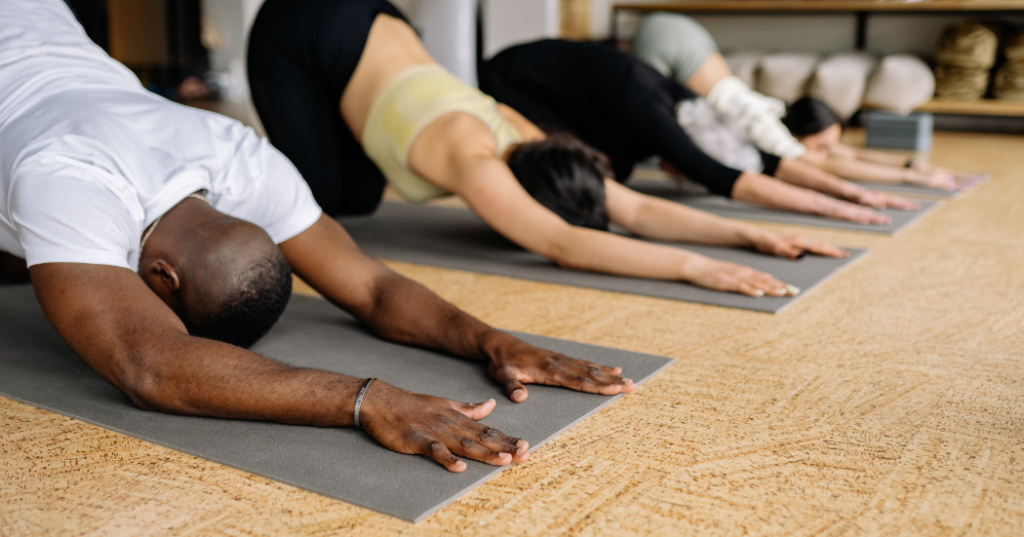Yoga has become increasingly popular in recent years, and for good reason. It offers many benefits for the mind and body, making it a perfect addition to any fitness routine.
Incorporating yoga into your fitness regimen can help you achieve balanced well-being, improve flexibility, build strength, and relieve stress. Whether you’re a seasoned yogi or a beginner, there are countless ways to incorporate this ancient practice into your daily life.
Understanding the Benefits of Yoga for Overall Health and Well-being
Before incorporating yoga into your fitness routine, it’s essential to understand its vast benefits for your overall health and well-being.
First and foremost, yoga is known for its ability to promote a mind-body connection. It encourages you to focus on your breath, allowing you to be present in the moment and cultivate a sense of mindfulness. Practicing mindfulness regularly will develop heightened self-awareness, enabling you to understand your body better and listen to its needs.
In addition to enhancing your mind-body connection, yoga also improves flexibility and mobility. The various poses and stretches performed in yoga classes target different muscle groups, helping to increase your range of motion. Improved flexibility helps prevent injuries and allows you to perform other physical activities more efficiently.
Moreover, yoga strengthens your muscles, including those often neglected in other forms of exercise. Holding poses and transitioning between them builds functional strength throughout your body, enhancing your performance in different fitness activities, such as weightlifting or running.
Lastly, practicing regularly can significantly reduce stress levels. The mindful breathing techniques and relaxation exercises involved in yoga help activate the parasympathetic nervous system, promoting calmness and relaxation. By incorporating yoga into your fitness routine, you can combat the daily stresses of life and improve your overall mental well-being.
Exploring the Different Types and Their Purposes
When incorporating yoga into your fitness routine, it’s essential to understand the different types of yoga and their specific purposes. This knowledge will help you choose the style that aligns with your goals and preferences.
Hatha Yoga is the most common and widely practiced form of yoga. It focuses on physical postures (asanas) and breath control (pranayama). Hatha classes are great for beginners as they provide a solid foundation and introduce basic poses.
Vinyasa: Vinyasa yoga is known for its flowing sequences of poses. It emphasizes the connection between breath and movement, allowing for a dynamic and energetic practice. If you’re looking for a more fast-paced and challenging workout, vinyasa is a great choice.
Ashtanga: Ashtanga yoga follows a sequence of poses performed precisely and continuously. This style is physically demanding and promotes strength, flexibility, and endurance. It is ideal for those who prefer structure and a more disciplined practice.
Restorative: Restorative yoga focuses on relaxation and rejuvenation. It involves holding gentle poses for an extended period while using supportive props to enhance comfort. The restorative style is perfect for reducing stress and promoting deep relaxation.
Hot: Hot yoga classes are performed in a heated room. The increased temperature helps loosen muscles and promotes flexibility. This style of yoga is physically demanding and is known to detoxify the body through increased sweating.
Now that you better understand the different types of yoga and their purposes, you can choose the style that resonates most.
Whether you’re looking to improve flexibility, build strength, reduce stress, or find a form of exercise that promotes overall well-being, yoga has something to offer everyone. So, roll out your mat, take a deep breath, and embark on a journey of self-discovery and self-care through yoga.

Integrating Yoga into Your Fitness Routine: Finding Balance with Strength and Flexibility Training
When incorporating yoga into your fitness routine, finding the right balance between strength and flexibility training is vital. It’s essential to recognize that yoga complements other forms of exercise and can be integrated seamlessly into your existing workout schedule.
Creating a Well-Balanced Routine
Start by assessing your fitness regimen and identifying areas where yoga can fill the gaps. If you primarily focus on strength training, incorporating yoga as a cool-down or recovery session can help promote flexibility and prevent muscle tightness.
On the other hand, if your routine mainly consists of cardiovascular exercises, such as running or cycling, incorporating yoga as a warm-up or post-workout stretch can help improve your performance and prevent injuries.
Aim to incorporate at least two to three weekly yoga sessions for a well-rounded routine. This will allow you to reap the full benefits of the practice without compromising other aspects of your fitness journey.
Combining Yoga with Strength Training
If building strength is one of your primary fitness goals, integrating yoga into your routine can enhance your progress. Combining yoga and strength training creates a harmonious balance between flexibility and power.
Consider adding poses that target the muscles you want to strengthen. For example, Warrior poses, down dog, and plank poses are great for building core and upper body strength. Incorporating these poses into your routine, you’ll develop a strong foundation and improve your overall muscular stability.
Certain styles, such as Power or Bikram Yoga, incorporate elements of strength training by incorporating more challenging poses and isometric holds in addition to individual poses.
Adding Yoga to Promote Flexibility
Incorporating yoga into your fitness routine is a no-brainer if flexibility is your main focus. The various stretches and poses in yoga classes target different muscle groups and help increase your range of motion.
Try incorporating dynamic stretching at the beginning of your sessions to warm up your muscles. Dynamic stretching involves moving through a range of motion to activate and prepare your muscles for the upcoming poses. Downward dog flow and sun salutations are excellent dynamic stretches that warm the entire body.
After your workout, dedicating a few minutes to static stretching can help cool down your muscles and promote flexibility gains. Positions such as forward fold, pigeon pose, and seated wide-leg forward bend are perfect for targeting tight muscles post-workout.
In addition to the physical benefits, integrating yoga into your fitness routine can also positively impact your mental well-being. Each session encourages mindfulness and deep breathing, which can help reduce stress and promote relaxation. By incorporating yoga into your fitness routine, you’ll care for your body and nourish your mind.
Furthermore, group practice can provide a sense of community and support. Joining a yoga class or participating in yoga workshops can connect you with like-minded individuals with similar fitness goals. This social aspect of the classes can enhance your overall fitness experience and provide a supportive environment for growth and self-improvement.
Enhancing Mental Clarity and Stress Reduction through Yoga Practice
Besides the physical benefits, yoga is deeply rooted in mindfulness and meditation practices. Incorporating these aspects into your yoga practice can enhance mental clarity and reduce stress.
The Power of Mindfulness
Mindfulness is being fully present and aware of the current moment without judgment. Yoga provides the perfect opportunity to cultivate mindfulness as you focus on your breath and the sensations in your body.
During sessions, try to let go of distractions and pay attention to your body’s sensations and movements. Paying attention to the quality of your breath can also help you tune in to the present moment.
Practicing mindfulness during yoga allows one to experience a deeper mind-body connection, quieten the mind, and reduce anxiety.
The Benefits of Meditation in Yoga
Meditation is a fundamental aspect of yoga that promotes mental well-being and relaxation. During yoga classes, instructors often guide students through guided meditation or encourage the practice of meditation during savasana, the final relaxation pose.
Meditation can help you develop a calmer and more focused mind, increasing mental clarity and reducing stress levels.
Take the time to explore different meditation techniques, such as breath-focused meditation or loving-kindness meditation, to find the practice that resonates with you the most. You’ll create a space for inner peace and self-reflection by incorporating meditation into your yoga sessions.
Furthermore, the benefits of meditation extend beyond the mat. Regular meditation practice has been shown to improve attention span, enhance emotional well-being, and even boost creativity. Dedicating a few minutes daily to meditation can cultivate a sense of calm and clarity that permeates all aspects of life.
In addition, mindfulness and meditation have positively impacted physical health. Research suggests these practices can lower blood pressure, reduce inflammation, and strengthen the immune system.
Incorporating mindfulness and meditation into your practice nurtures your mind and supports your overall well-being.
Practical Tips for Beginners: Starting Your Yoga Journey Safely and Effectively
If you’re new to yoga, starting your practice safely and effectively is crucial for a positive experience. Here are some practical tips to help you get started:
Find the Right Class or Instructor
When first starting, it’s essential to find a suitable class or instructor who caters to beginners. Look for classes labeled “beginner-friendly” or “intro to yoga.” These classes typically focus on the basics and modify each pose to accommodate different levels of flexibility and strength.
Additionally, a knowledgeable instructor who can guide you through proper alignment and correct form is essential in establishing a solid foundation for your practice.
Listen to Your Body
Listening to your body is one of the most important aspects of starting a yoga practice. As you explore different poses and stretches, be mindful of your limitations and avoid pushing yourself too hard.
Feeling discomfort or resistance in certain poses is perfectly normal, but sharp or shooting pain is a sign that you may be pushing yourself too far. Remember to honor your body’s boundaries and progress at your own pace.
Invest in Basic Yoga Equipment
While yoga can be practiced with minimal equipment, investing in some essential equipment can enhance your experience. A yoga mat provides cushioning and stability during poses, while blocks and straps can help modify poses to suit your level of flexibility.
Wearing comfortable, breathable clothing that allows freedom of movement is also essential for a relaxed practice. Investing in these basics will make your practice more enjoyable and help prevent injuries.
Incorporating yoga into your fitness routine is an excellent way to achieve mind-body wellness. By understanding the benefits and selecting the right style for your goals, you can integrate this ancient practice seamlessly into your fitness regimen.
Whether you want to improve flexibility, build strength, enhance mental clarity, or reduce stress, yoga offers a holistic approach to overall health and well-being. So grab your mat, find a class that suits your needs, and embark on your yoga journey today!


